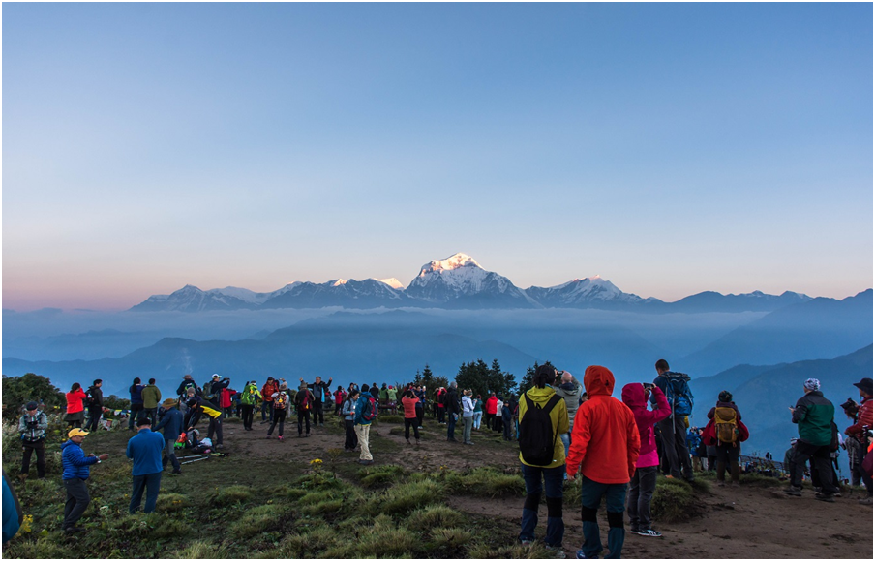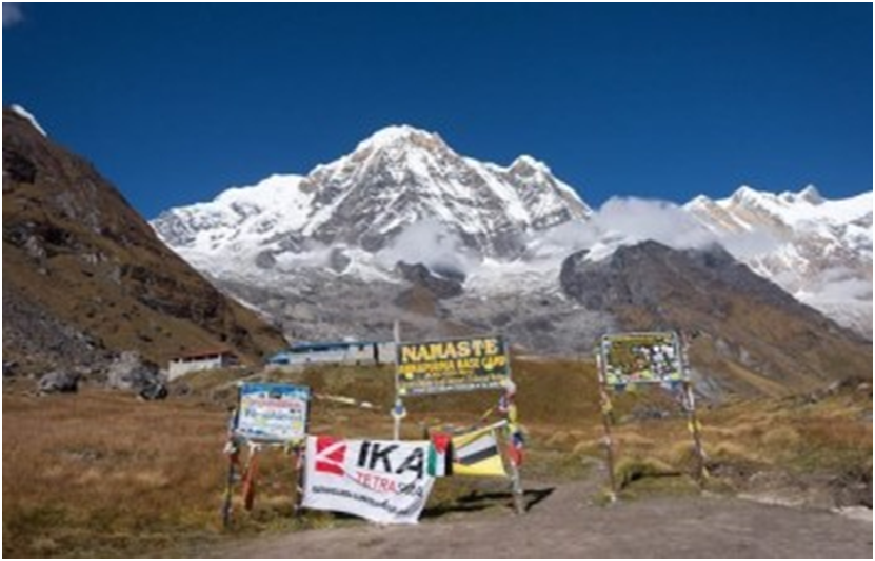
Nestled in the heart of Nepal’s Annapurna locale, Poon Hill is a notorious goal that guarantees a mesmerizing Himalayan dawn, fabulous sees of snow-capped crests, and a trekking involvement cherished by travelers around the world. At a height of 3,210 meters, this peak offers all-encompassing views of the Annapurna and Dhaulagiri mountain ranges. If you’re looking for a trek that combines reasonable exertion with breathtaking rewards, the Poon Slope Dawn involvement is ideal for you. Let us take you on a point-by-point trip through this unimaginable experience, consolidating fundamental components of the Annapurna Circuit, shorter trekking courses, the Ghorepani Poon Hill trek, the best time to visit, and much more.
Annapurna Circuit Trek
The Annapurna Circuit trek is one of Nepal’s most celebrated trekking courses, encompassing the magnificent Annapurna Massif. Crossing 160-230 kilometers depending on the course you select, this trek offers an unparalleled mix of normal excellence, social differences, and exciting challenges. Beginning from the rich green valleys of the Marshyangdi Waterway, the trek takes you through elevated timberlands, dry high-altitude scenes, and curious towns embellished with dynamic Tibetan Buddhist influences. The Annapurna Circuit trek is a requesting, however fulfilling, trip. Trekkers cross the imposing Thorong La Pass at a height of 5,416 meters, one of the most noteworthy trekking passes in the world. Along the way, you’ll experience fabulous sights, including the Annapurna extend, Manaslu, and indeed removed crests of the Tibetan Level. The differing qualities of the path Along the way, you’ll experience fabulous sights, counting the Annapurna extend, Manaslu, and indeed removed crests of the Tibetan Level. to its social offerings, as you are associated with individuals from Gurung, Thakali, and Tibetan communities.
it a great choice for acclimatization or a picturesque reroute that presents you with the magnificence of the Himalayas without the rigors of high-altitude trekking.
Short Annapurna Circuit Trekking
For those who are brief on time or favor a less strenuous enterprise, the Short Annapurna Circuit trek offers a perfect elective. This truncated adaptation of the classic circuit is outlined to give trekkers a taste of the region’s staggering scenes and social abundance without the requests for long days and high-altitude crossings. One of the most prevalent beginning focuses for the Brief Annapurna Circuit is Besi Sahar to Chame, which leads you through fabulous segments of the path, including Manang Valley and the lower inclines of the Annapurna run. Numerous agendas skip the Thorong La Pass to diminish trouble, instead centering on lower-altitude zones wealthy in biodiversity and conventional villages.
Combining this shorter trek with a visit to Poon Hill makes for an incredible schedule. After dousing in the excellence of the Annapurna foothills, you can head to Ghorepani and climb to Poon Slope for its celebrated dawn. This combination conveys a total Himalayan encounter, mixing social inundation, direct trekking, and extraordinary vistas into a reasonable package.
Ghorepani Poon Hill Trek
The Ghorepani Poon Hill trek is a culminating presentation of trekking in Nepal, regularly alluded to as the “Door to the Himalayas.” Known for its direct trouble, this trek is open to fledglings, families, and prepared trekkers alike. The travel regularly starts from Nayapul, approximately an hour’s drive from Pokhara, Nepal’s enterprise hub. The path winds through pleasant towns, rhododendron woodlands, and terraced farmlands. One of the highlights of this trek is the dynamic Gurung and Magar culture, as the course passes through towns like Tikhedhunga and Ghorepani. These communities offer a warm welcome to trekkers, along with openings to investigate neighborhood conventions and cuisine.
The climax of the Ghorepani Poon Hill trek is without a doubt the early morning climb to the Poon Slope perspective. Beginning in the pre-dawn hours, trekkers climb the slope with spotlights in hand, energized to witness the enchantment of dawn over the Himalayas. As the beams of daylight begin to kiss the snow-capped crests of Annapurna I, Dhaulagiri, Machapuchare (Fishtail), and Hiunchuli, the scene changes into an otherworldly exhibition. This breathtaking scene takes off each guest in wonder, making the exertion to reach Poon Slope more than worthwhile.
Best Time to Visit Poon Hill
Timing your visit to Poon Slope is significant for maximizing the involvement. The best seasons for trekking in this locale are spring (March to May) and harvest time (September to November).
Spring (March to May):
This is an incredible time to trek, with clear skies, direct temperatures, and sprouting rhododendrons, including dynamic sprinkles of color to the scenes. The timberlands along the path come alive with blooms, making a pleasant setting that upgrades the trek’s charm.
Autumn (September to November):
Autumn is the most prevalent season for trekking in Nepal. Post-monsoon clarity guarantees unparalleled views of the mountains, whereas the climate remains steady and charming. The fresh dusk, brilliant daylight, and dry trails make this a perfect time for the Poon Slope experience.
Winter (December to February):
Trekking in winter is conceivable, but temperatures can drop significantly, particularly at night. Snowfall may too limit getting to certain parts of the path. Be that as it may, winter trekking offers a calmer encounter and stunningly clear seas for those who can brave the cold.
Monsoon (June to August):
Monsoon season is not perfect for trekking due to overwhelming precipitation, leech-infested trails, and decreased permeability. Be that as it may, this season brings lavish greenery to the locale, making it a one-of-a-kind involvement for those willing to take on the challenge.
Equipment
For Simple Sightseeing Tours in Kathmandu and beyond:
- Personal Toiletries are a small day pack or bag to carry your personal belongings such as water bottles, cameras, wallets, maps, journey/notebooks, cell phones, light jackets, or fleece and insect repellent cream as per the season.
- Running /sports shoes or comfortable shoes for short walks, for elderly people walking poles, personal medication, binoculars as an option, T-shirts, long sleeve shirts, trousers (while entering temples and monasteries) sunscreens.
- Sun Hats, Sunglasses, for long drives, soft inflatable cushions/pillows, are advisable options, and rainproof or umbrella.
For Moderate Hikes and Treks:
- Personal Toiletries, a moderate-size daypack to carry your personal belongings such as water bottles, cameras, wallets, maps, journey/notebooks, cell phones, light jackets, or fleece and insect repellent as per the season.
- Running/sports shoes, for elderly people walking poles, personal medication, binoculars an option, T-shirts, long sleeve shirts, trousers (while entering temples and monasteries) sunscreens, and torch/flashlights.
- Sun Hats, Sunglasses, and water bottles are necessary (try to avoid plastic bottled water as they make litter which is hard to recycle in Nepal) use the same waterfalls to refill your bottle where available, rainproof or umbrella. Scarf or mask to avoid dust and smoke.
For long Trekking for a week or more above 3,000 meters:
- Personal Toiletries, a moderate-size day pack or rucksack to carry your personal belongings such as travel documents, water bottles, cameras, wallets, maps, journey/notebooks, cell phones, light jackets, or fleece insect repellent as per the season.
- Running/sports shoes, good pair of boots, warm woolen/cotton socks, snow gaiters, rain/windproof gear, walking poles an option, personal medication, binoculars an option, T-shirts, long sleeve shirts, trousers (while entering temples and monasteries) sunscreens, torch/flashlights.
- Gloves, Woolen Beni (camp) Sun Hats, Sun/snow glasses, and water bottles are necessary (try to avoid plastic bottled water as they make litter which is hard to recycle in Nepal) use the same waterfalls for refills where available. Scarf or mask to avoid dust and smoke.
- On trekking, bigger kit/duffel bags are carried by porters/pack animals (yaks, mules, or ponies) which include your heavy personal gear that is sleeping bags, down / duvet jackets, and the items that you do require during daytime on walks till designated campsites/lodge.
Itinerary for Poon Hill Sunrise Trek
Day 1: Arrive in Kathmandu and receive by Team Himalaya staff.
Day 2: Drive to Pokhara 950m – 06 hrs. Journey.
Day 3 : Drive to Nayapul 1,100m and trek to Tirkhedhuga 1,450m.
Day 4: Trek to Ghorepani 2,874m – 06 hrs.
Day 5: Morning hike to Pun-Hill trek to Tadapani 2,721m – 05 hrs.
Day 6 : Trek to Tolka 1,630 m – 06 hrs.
Day 7 : Trek to Kande 1,460m and drive to Pokhara.
Day 8: Drive back to Kathmandu afternoon free at leisure.
Day 9: In Kathmandu full-day sightseeing tour.
Day 10: International departure homeward bound.
Conclusion
The Ghorepani poon hill trek is more than a fair trek—it’s an encounter that will wait in your heart for a lifetime. Whether you’re a prepared trekker or a first-time globe-trotter, the Himalayan screenplay unfurls flawlessly at Poon Slope, where nature’s glory meets social lavishness. Combining this trek with components of the Annapurna Circuit or picking a shorter trekking course upgrades its request, advertising something for everybody. With legitimate arranging and the right timing, Poon Slope guarantees recollections that will remain carved in your soul forever.
FAQs
- Is the Poon Slope trek reasonable for beginners?
Yes, the Poon Slope trek is considered a direct trek, reasonable for apprentices and families with essential wellness levels.
- Do I require a direct for the trek?
While the path is well-marked, enlisting a direct or joining a trekking gathering can upgrade your involvement and give you social insights.
- What licenses are required for the Poon Slope Trek?
Trekkers require the Annapurna Preservation Region Allow (ACAP) and a TIMS (Trekkers’ Data Administration Framework) card.
- Can I combine Poon Slope with other treks?
Absolutely! Poon Slope can be coordinated into the Annapurna Circuit or Annapurna Base Camp treks for a more comprehensive adventure.
- How physically demanding is the Poon Slope Trek?
The trek includes direct risings and plunges but is sensible with a sensible wellness level. No earlier trekking involvement is necessary.
- What ought I to pack for the trek?
Essentials incorporate strong trekking boots, layered clothing, a good-quality rucksack, trekking posts, sunscreen, a first-aid pack, and a camera to capture the views.
Embark on the Poon Slope Dawn enterprise and let the enchantment of the Himalayas unfurl before your eyes. The magnificent crests, dynamic societies, and exceptional dawns await!
Contact Us Team Himalaya For More Info
Team Himalaya Pvt. Ltd. is a trusted local trekking company based in Kathmandu, Nepal. We specialize in organizing multi-day tours, treks, climbing adventures, expeditions, and other related activities for solo travelers and private groups. Our services extend across Nepal, Bhutan, and Tibet.
For inquiries,
feel free to reach out to us at info@teamhimalaya.com or via Whats App at +9779841824281.

